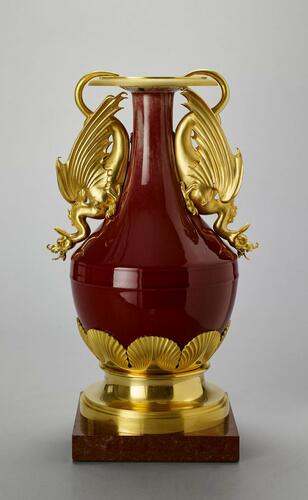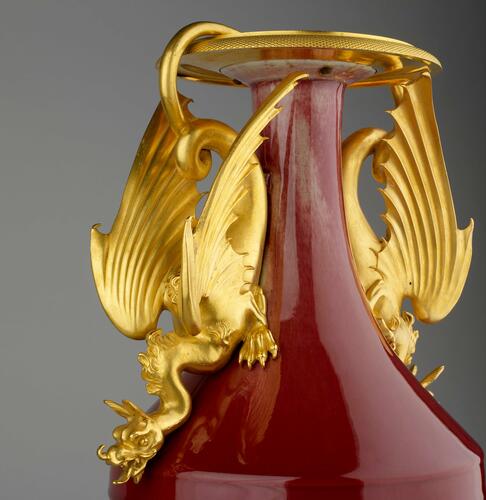Vase with mounts second half of 18th century, mounts: 1807
Porcelain with flambé copper-red glaze and gilt bronze | 46.5 x 26.5 x 23 cm (whole object) | RCIN 881
-
A Chinese porcelain vase with English gilt-bronze mounts. Broad-based bottle vase, with an indented band at the shoulder, the neck tapering to a mouth with flared lip. The deep red glaze is flecked with darker streaks, and thins on the neck to a paler shade with creamy-blue streaks; inside, the neck is plain-glazed with a dark crackle. The top of the vase with a broad, circular, spreading rim, with milled edge simulating a tightly woven pattern, and with smooth burnished inner part with two raised ridges, in between which is a lozenge-hatched ground. The rim mount extends just inside the lip of the vase (unlike its blue glazed companion RCIN 187, on which the rim mount extends down into the neck of the vase as an enclosed deep cup). On either side of the neck are a pair of descending gilt-bronze dragons with half-opened wings, their tails attached to the top rim and their front legs on the shoulder; in fitting the dragons by means of screws through the vase, porcelain side handles were removed, remnants of which are just visible under the tails. The vase’s foot is supported by a cup of eight shell-like lotus leaves, rising from a broad-waisted stem with two-tiered step, which is attached to a square plinth of antique red (rosso antico) marble. The inside of the foot of the vase is hollowed out, and the marble plinth and gilt-bronze mounts around the base are attached to the vase by means of two crossed bars, fixed inside the base of the vase.
Mounted by Vulliamy in 1807, en suite with the blue-glazed vase RCIN 187, on which the gilt-bronze dragons are of a slightly different model and inverted. His account reads ‘For Mounting a very Large Red Crackled China Bottle in a very sumptuous manner Made Two very Large winged Imperial Dragons highly Chased for handles … the bottle is fixed up on a very fine Red Marble Plinth ... £52.10.–’. Also included in the delivery was a ‘very Large blown Glass Shade to cover the bottle £4.10.–’, and a ‘circular Stand with a purplewood moulding all round covered with the best crimson Genoa Velvet so as to totally exclude the dust £2 2s’ (National Archives C104/58(II), Ledger no. 32, p. 241). Thirteen different craftsmen were employed by the Vulliamys in the creation of the mounts, the cost of both vases totalling £85 19s 11d (National Archives C104/57(I) Ornament Book no. 3, pp. 42–5. While the rare copper-red glazes of the early Ming period underwent a revival at the court of Kangxi (1662–1722), the period is better known in the West for its creation of the strikingly brilliant sang-de-boeuf wares. These are subject to uneven effects of colour owing to the fugitive quality inherent in the medium. Later in the eighteenth century, it resulted also in the making of flambé wares with purplish markings, which are at times due to the deliberate addition of cobalt blue.
Text adapted from Chinese and Japanese Works of Art in the Collection of Her Majesty The Queen: Volume II.Provenance
Supplied by Vulliamy to George IV when the Prince of Wales, for Carlton House, 1807.The record of the delivery of this vase and its companion, RCIN 187, to Brighton in March 1819 states that they were taken from the Bow Room (Jutsham Dels I.310), and both may be seen in Charles Wild’s earlier watercolour of the Rose Satin Drawing Room at Carlton House (Pyne 1819, II, pl. opp. p. 32). Recorded in the Music Room at the Royal Pavilion, as ‘A maron China Bottle, mounted in ormolu, with broad tip and Dragon handles shell cup and moulding circular base, on a square red marble plinth, eighteen inches [45.7 cm]’ (1829B, p. 34); it was sent to Buckingham Palace in March 1847 (1829A, p. 20), and in March 1914 noted in the Principal Corridor (Brighton Pavilion Inventory of Clocks and China 1828, p. 67).
Exhibited in Carlton House: The Past Glories of George IV’s Palace, The Queen’s Gallery, London, 1991–2 (with RCIN 187); Chinese Whispers: Chinoiserie in Britain, 1650–1930, Brighton Museum and Art Gallery, Brighton, 2008. -
Creator(s)
(nationality)(metalworker)(metalworker)Acquirer(s)
-
Medium and techniques
Porcelain with flambé copper-red glaze and gilt bronze
Measurements
46.5 x 26.5 x 23 cm (whole object)
Category
Object type(s)












